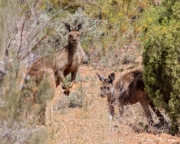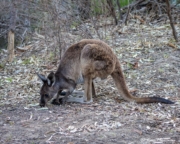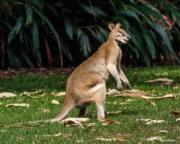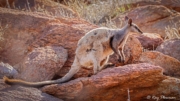Egg-laying and Marsupial Mammals
This photo album comprises three galleries, the first features egg-laying mammals. Marsupial mammals displayed in the second include kangaroos, wallabies, and relatives while the third contains possums, carnivorous marsupials, and bandicoots. See Taxonomy note at the end of this page. Many displayed photos are Australian icon mammal species.
Egg-laying Mammals
Egg-laying Mammal Notes
Both featured species are ‘Red List 2020-2’ as ‘Least Concern’.
There is a walking track along Peterson Creek in Yungaburra a small village in the Atherton Tablelands region of Queensland. An excellent place for wildlife, including birds, possums, and duck-billed platypuses. The platypus is an Australian endemic and icon, one of only two egg-laying mammals in the world. The other egg-laying mammal is the short-beaked echidna which has five subspecies. The nominate subspecies I photographed in Flinders Range National Park in South Australia. Tachyglossus aculeatus lawesii is native to Australia, and New Guinea, the other subspecies are Australian subspecies endemics.
Kangaroos, Wallabies and Relatives
![Common [Coarse-haired] Wombat (Vombatus ursinus tasmaniensis) on scrubland near Weaning Paddock Creek, Cradle Mountain Road in Tasmania Common [Coarse-haired] Wombat (Vombatus ursinus tasmaniensis) on scrubland near Weaning Paddock Creek, Cradle Mountain Road in Tasmania](https://rayplowman.co.uk/wp-content/uploads/cache/2020/08/Common-Bare-nosed-Wombat-_AU_3100s/1246244134.jpg)


![Euro [Wallaroo] (Macropus robustus erubescens) female with Juvenile at Olive Pink Botanic Garden in Alice Springs Euro [Wallaroo] (Macropus robustus erubescens) female with Juvenile at Olive Pink Botanic Garden in Alice Springs](https://rayplowman.co.uk/wp-content/uploads/cache/2020/08/Euro-Wallaroo-Female-with-Juvenile-_D4_4903dhs/1952206399.jpg)


![Bennetts Wallaby [Red-necked] (Macropus rufogriseus) with Joey in a pouch at Freycinet National Park in Tasmania Bennetts Wallaby [Red-necked] (Macropus rufogriseus) with Joey in a pouch at Freycinet National Park in Tasmania](https://rayplowman.co.uk/wp-content/uploads/cache/2020/08/Bennetts-Wallaby-Red-necked-Joey-_AU_3283sd/2235656881.jpg)
![Bennetts Wallaby [Red-necked] (Macropus (Notamacropus) rufogriseus) at Freycinet National Park in Tasmania Bennetts Wallaby [Red-necked] (Macropus (Notamacropus) rufogriseus) at Freycinet National Park in Tasmania](https://rayplowman.co.uk/wp-content/uploads/cache/2020/08/Bennetts-Wallaby-Red-necked-_AU_3336s/1820541272.jpg)
Kangaroos, Wallabies and Relatives Notes
Apart from the black-footed rock wallaby ‘Red List 2020-2’ Vulnerable’ other featured species are listed as ‘Least Concern’ and are all Australian endemics.
Koalas spend most of their day asleep in eucalyptus forests where they feed on the leaves for just a few hours each day. Most of my sightings have been of individuals asleep, but occasionally, I photographed them feeding. The three featured photos show a female cradling here joey but keeping a watchful eye on me, an individual catching the sun and one foraging in the eucalyptus trees.
There are three wombat species (Northern and Southern ‘hairy-nosed’ and ‘common or coarse-haired’). One of the three common wombat subspecies is widespread and endemic to Tasmania. Wombats are nocturnal feeders spending the day in their burrows. My wife was driving down from the snowed-in Cradle Mountain National Park, although at lower altitude it was still cold. We spotted a wombat grazing in a meadow near the road. Wombats are nocturnal feeders but will feed during the day if it is cold.
There are around fifty macropods (kangaroos, wallabies, and relatives). Kangaroos are the largest macropods; the gallery displays both eastern and western grey kangaroos. The Euro (wallaroo) is an intermediate size kangaroo. Wallabies, rock-wallabies and pademelons are amongst the smallest macropods; several species feature including a large male and smaller female mid-sized agile wallaby.
Possums, Carnivorous Marsupials and Bandicoots
Marsupial Notes
The green ringtail possum is ‘Red List 2020-2’ as ‘Near Threatened’, all other displayed species are listed as ‘Least Concern and are all Australian endemics.
Possums, gliders, and bandicoots are nocturnal marsupials, but apart from the green ringtail possum, I photographed these in the evening under artificial lighting conditions. Yellow-footed antechinus is more active in the day although I this individual and the long-nosed bandicoot was active in the evening.
Egg-laying and Marsupial Mammal Taxonomy
The Mammals Photo Album webpage describes the higher-level taxonomy for the featured families placed in Monotremata (Monotremes) and infraclass Metatheria (Marsupial Mammals).
Egg-laying Mammals comprise two families: Ornithorhynchidae (Platypus) and Tachyglossidae (Echidnas), each with one genus/species.
Marsupial Mammals galleries feature species from eight families:
(a) Macropodidae (Kangaroos, Wallabies, and Relatives),
(b) Phascolarctidae (Koalas),
(c) Vombatidae (Wombats),
(d) Dasyuridae (Dasyurids),
(e) Phalangeridae (Brushtail Possums),
(f) Pseudocheiridae (Ringtail Possums),
(g) Petauridae (Gliders, and Striped),
(h) Peramelidae (Bandicoots).







![Euro [Wallaroo] (Macropus robustus erubescens) at Flinders Range National Park in South Australia](https://rayplowman.co.uk/wp-content/uploads/cache/2020/08/Euro-Wallaroo-_D4_6217hs/425385416.jpg)












